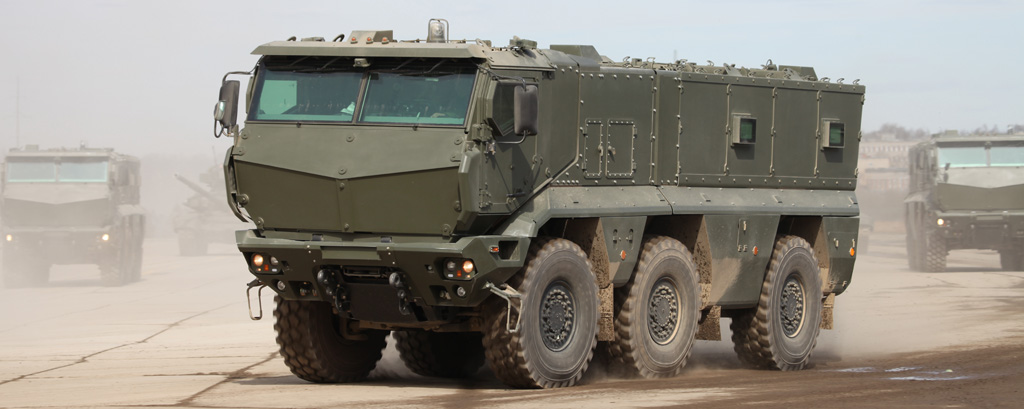
Victory Day Parade 2014 rehearsal Alabino Typhoon
The KamAZ-6396 Typhoon is a family of Russian Modular, Armored, Mine-Resistant Ambush Protected (MRAP) vehicles made by the truck builder KAMAZ. It is a whole family of 6x6 vehicles under the Typhoon program, and by 2021, 330 units Typhoon-K had been received so far. The Typhoon exist in deed in 4x4, 6x6 and 8x8 variants, respectively receiving the manufacturer code 5388, 6396 and 6368. This post is about the 6396 and its single cargo variant Kamaz 63968. It was Exported or demonstrated so far to Turkmenistan, Uzbekistan. Ukraine captured some. So far, 28 Typhoon cargo and 9 Typhoon APC were either lost or captured in the current war in ukraine.
The Russian truck MRAP
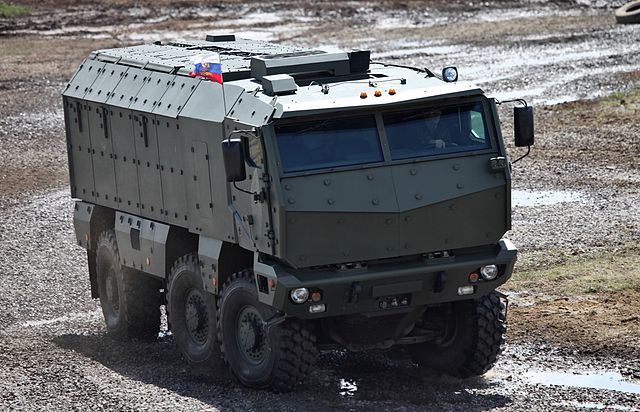
Prototype KamAZ 63968 at Engineering Tech 2012
Development of the "Typhoon" family of vehicles started back in 2010: The then Minister of the Russian Federation Armed Forces approved Development of a new set of military vehicles scheduled up to 2020. The program was framed under the "Typhoon" (Тайфун) MRAP program sharing a lot of parts from the manufacturers, not only between them but with other commercial platforms of the manufacturer to lower acquisition prices. In 2012 a first contract was signed with KAMAZ on the Typhoon program, expecting a common platform that could be declined into 4x4, 6x6 and 8x8 vehicles. The first studied by the KamAz-5388 4x4. The program was not reserved only to Kamaz and to grow numbers, Ural was also associated, producing at the same time the Ural-63099 Typhoon and ZIL the Karatel 4x4 based on the KamAZ-4911. Here again, the first and second number indicates axles.
The "Typhoon-K" was designed as a MRAP defined as part of the “Concept for the development of military vehicles of the Armed Forces of the Russian Federation for the period until 2020” outlining unified families of vehicles, and this platform was designed as new stage in development for universal domestic vehicles since 1961. In short, since the BTR-60... In shape and technology it demonstrated a radical departure over vehicle doctrinces and designs from that erea, leading to the very similar BTR-60, 70, 80 and 82 families to this day, all having a rear-mounted engine and side, between axles exit. A singular solution not repeated as the new vehicle was to be much taller in order to procure the requisited mine blast protection, conventionally placed engine and rear access and exit.
Development
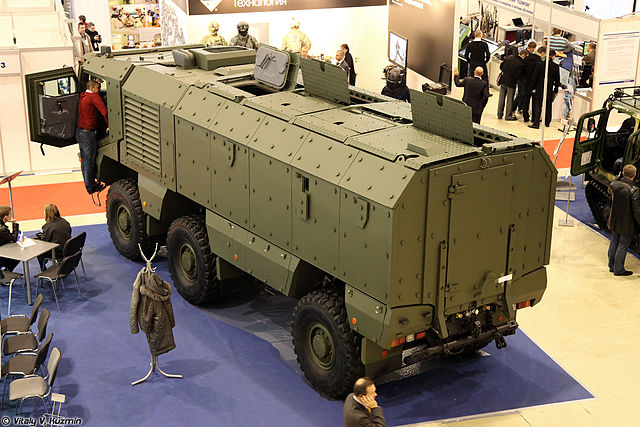
Prototype at Interpolitex 2013
The history of the entire Typhoon family starts in 2010, as the Minister of Defense (MoD) of the Russian Federation approves the “Concept for the development of military vehicles of the Armed Forces of the Russian Federation for the period until 2020”. He prescribes the development of highly standardized wheeled armored vehicle platform. As a result, the single platform called "Typhoon" is created, and whatever the chassis axles, the vehicle sould carry troops and cargo while providing fill all around protection from small arms, shrapnel and landmines.
The base platform should be able to mount various equipment, to be the basis for a communication vehicles, mobile artillery system or a crane truck and ARV, or UAV launch vehicle, cargo and excavator (CEV) among others. Specialists from the Ural Automobile Plant, Avtodizel OJSC (GAZ Group) as well as the Technical Center of KAMAZ OJSC were to partner with the Steel Research Institute for the armor design as well as the Federal Nuclear Center in Sarov plus Magistral ltd. for the armored glass, Bauman being involved in the development of the hydropneumatic suspension. Many others and suppliers took part to this massive program aimed at repacing the whole BTR family, ingeritance of the cold war. Many specifics of the MRAP-oriented design came from recent combat losse analysis. Emphasis was put on mine protection.
Production
In December 2014, the Southern Military District obtained the first batch of 30 Typhoon 6x6. In January 2015, the Southern Military District received 20 more vehicles and later the Typhoon-K is scheduled to be provided to engineers, to the military police as well as the FSB and frontier guards as well as special forces (notably the Spetnaz). To this day, production numbers are diverging greatly, with a relative consensus around 330. That's a small number compared to the thousands stocks of BTRs going back to the 1960s BTR-60 (tens of thousands built). As for other projects, it's dubious the Russian Federation will be able to ramp up production.Design of the KamAZ 6396
General design
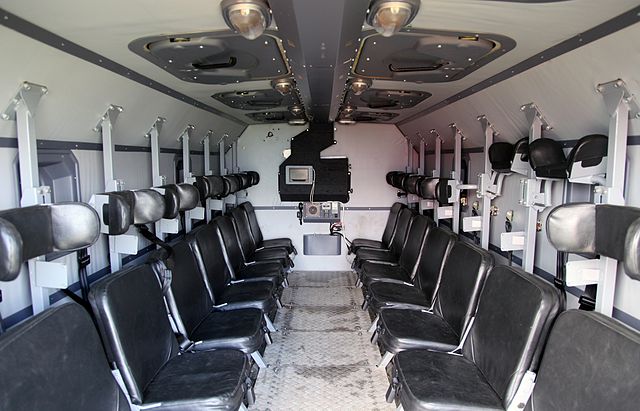
Interior of the APC
The Typhoon K is designed for high capacity, a true APC with a higher capacity than previous BTRs hence the general hull design, in flat surfaces instead of a complicated primastic hull of previous BTRs, not ideal on the standpoint of internal space. Reconnaissance roles ar devoted to the family 4x4. As an APC it can carry no less than 16 men, a full platoon, with their equipment in the rear compartment. As a reminder on the previous BTR 8x8 family this was 12 in normal conditions. Combined power of these vehicles was 180 hp for the first BTR-60, to compared to the c500 on the new vehicle.
Variants
The base Typhoon-K 6x6 is a baseline armoured configuration, to be declined into a Reconnaissance vehicle, a Command and Control vehicle, APC, Medical vehicle, Engineering Intelligence vehicle, NBC reconnaissance vehicle, and escorting/fire support MRAP. The chassis Typhoon-U is the universal unprotected truck family of the Army, declined into a pontoon carrier, fuel tanker, unarmoured recovery vehicle, communication vehicle, UAV mobile base, MLRS and mobile artillery system, crane truck, multilift truck, and container tractor.Mobility
This truck is a 6×6 integral power passed to all wheels, with adjustable hydraulic dampers. The front mounted engine is accessible behind the cab, which can be lifted up at the pressing of a button. The power unit is a YaMZ-5367-I6, rated for 450 hp designed and provided by the Yaroslavl Motor Plant. It is coupled with a YaMZ 8 gears automatic gearbox. Top speed is 110 km/h on road, 700 km in max range, with a fuel consumption of 81 liters for 100 km.Despite its large size and bulk, the Typhoon K is supposed to be agile, with a turning radius stated to be below 10 meters, an adjustable ground clearance which could provide elevation angles forward and back to 23 and 30° as well as a max wheel angle of 39°. Other sources gives an amplitude of 185 to 575 mm in ground clearance, and a max range of 750 miles or 1,200 km a top speed more reasonable of 105 km/h (65 mph).
Protection
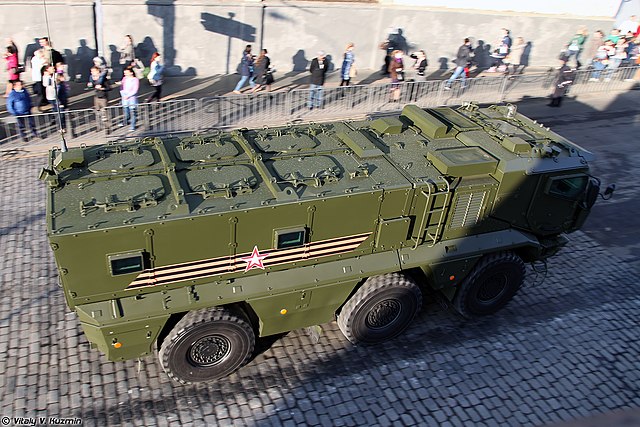
Roof view
The armor was designed to match NATO STANAG 4569, level 3b. It was designed to withstand high-explosive fragmentation warheads and up to 8 kg TNT at any angle. Bulletproof protection is equivalent to level four. Combined ceramic and steel armor protects the crew against armor-piercing 14.5 x 114 mm shells. The small armored glass windows reach 128.5-129 mm in thickness, still with a transparency of 70%.
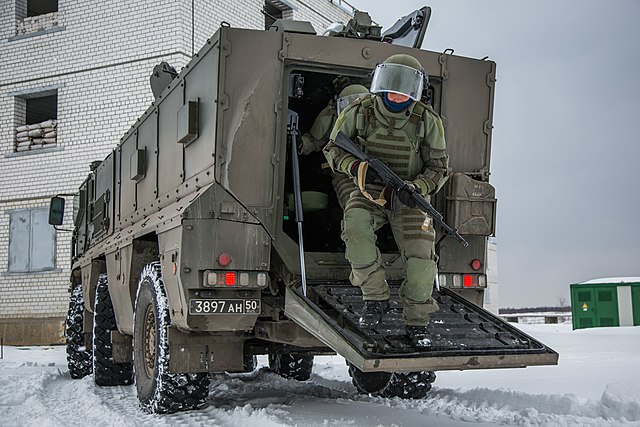
Rear ramp down
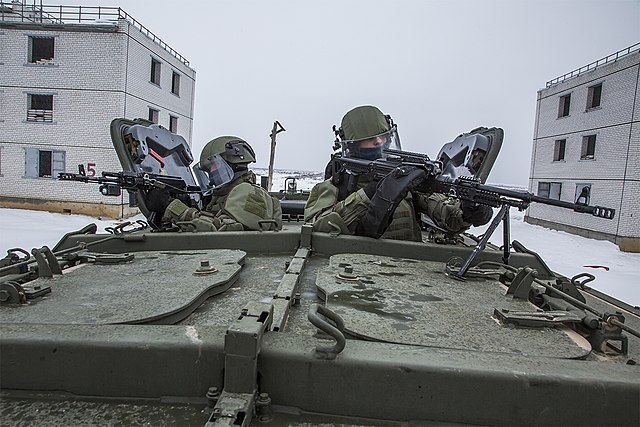
Engineers ready to fire through hatches
They were ordered to Magistral LTD, tested at the Steel Research Institute, as able to resist 2 shots at 280 and 300 mm from a KPVT, muzzle velocity of 911 m/s on impact. This exceeds requirements on the GOST R 51136 and GOST R 50963 metrics, well above B-32 standard, proof against 7.62 x 54 mm armor-piercing cartridges from SVD. During production, Magistral-LTD was guided by Western standards of level IV STANAG 4569 - guaranteed protection when fired by armor-piercing ammunition as well as 14.5 × 114 mm from 200 m.
Bulletproof and runflat tires of 16.00 R20 size are also provided. As usual they come with a fully automatic air inflation system, with adjustable pressure up to 4.5 atmospheres. The hull provided some pistol ports for small arms, and on option comprised a remote-controlled light machine on the forward roof section (see later). Unification with the rest of the Typhoon family is estimated and declared of 86%.
The seats have personal weapon holders, seat belts and headrests and they are fixed to the roof to reduce blast forced from underneath and concussion. The vehicle had a basic NBC collective protection with an FVUA-100A filter, ventilation unit, air conditioner. Unlike all previous BTRs, the Typhoon had a standard access/exit ramp at the rear to dismount under fire, while still keeping a heavy armoured door on either sides. There are also emergency roof hatches and in the floor in case the vehicle overturns. The ramp is hydraulically supported, electrically activated.
Armament
The basic model is unarmed, the infantry could provide small arms fire on the move thanks to six roof hatch to stand in, and three firing ports either side. They are "blind", with fodling armoured caches when not in use. The mpst interesting hiwever is th variant armed with a w/RP-377 VM1 radio fuse jammer coupled with the remote weapon station Arbalet-DM RCWS module installed forward. Other modules can be installed depending on the mission at hand.Equipments
Surveillance and communications equipment: The car is equipped with an On-Board Information and Control System (BIUS) GALS-D1M for monitoring and regulating engine operation, calculating vehicle roll, road inclination, speed, location, etc. The independent hydropneumatic suspension allows the driver to change the ride height on the go, using a remote control within a range of 400 mm. Typhoon K-63968 is equipped with five video cameras for all-round viewing in the landing module and cockpit. The cabin is equipped with folding monitors showing both the vehicle's condition and external visibility.6x6 Typhoon K specifications | |
| Dimensions (L-w-h) | 8,99 x 2,55 x 3,12/3,30m |
| Total weight, battle ready | 21 light, Gross 24t, max 30t |
| Crew | 2+16 infantry |
| Propulsion | Yamz 5367 I6 450 HP and 8 gears automatic gearbox |
| Speed (road) | 110 km/h |
| Range (on flat) | 700 km, consumption 81l/100 km |
| Armament | None, see notes |
| Armor | Stanag 4569 lvl 2-4, see notes |
| Total production | 330 (2021) |
Deployment
Twelve Typhoons took part in Russian Victory Day military parade in 2014. State tests were completed in 2019. The KamAZ Typhoon was used by the Russians in the Russo-Ukrainian War with at least 25 KamAZ-63968 Typhoon and 8 K-53949 Typhoon-K destroyed, damaged or abandoned and captured as of 11 September 2023. A slightly downgraded Typhoon-K was offered for export in April 2023. In 2017 specialists from the MPMC went with these in Syria for demining freed areas of Syria. The vehicle was used in the current Russian Invasion of Ukraine in 2022 and by June 17, 2022, 3 Typhoon-Ks, captured in the counter-offensive, are suposed to be now in Ukrainian service. Russian had officially 260 Typhoon-K as of May 2017 with 22 lost in 2022, 28 Typhoon cargo and 9 APC lost or captured. There are no export customers but Turkmenistan which received an undisclosed number of "Typhoon-K", shown publicly at the parade in honor of the 30th anniversary of the Independence.Related links
on army-guide.comon weaponsystems.net
русская-сила.рф kamaz63968
русская-сила.рф taifun
armyrecognition.com
русская-сила.рф kamaz63969
oryxspioenkop.com, Turkmenistan variant
en.topwar.ru
army-technology.com
armyrecognition.com
militaryfactory.com
Southern Military District special forces received a batch of Typhoon armored vehicles
ria.ru "Typhoon" for the army. Special forces tested new armored vehicles
Technical characteristics of KamAZ Typhoon
By the end of the year, special forces of the Southern Military District will receive 60 of the newest armored vehicles of the Typhoon family.
Armored glass has been developed for protection when fired from a Vladimirov heavy machine gun (KPVT) with B-32 armor-piercing ammunition of 14.5 × 114 mm caliber.
function.mil.ru
tass: Troops in southern Russia received 20 more Typhoon armored vehicles
tass: The Russian Ministry of Defense received 30 Typhoon armored vehicles for military use.
KamAZ "Typhoon" and "Lynx" overcome obstacles at a training ground in the Moscow region
Vehicle guide
Will “Typhoon” and “Lynx” come to the army?. Information agency "Arms of Russia", December 24, 2011
Chief designer Remdizel: expanding the line of Typhoon-K armored vehicles for the Russian army
ru.wikipedia.org
en.wikipedia.org
Losses in Ukraine, oryxspioenkop.com
amps-armor.org
Creative Commons Video
Model kits

Illustrations
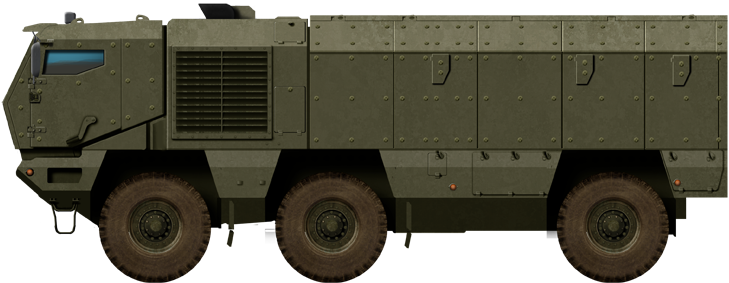
Typhoon K prototype, quite different from the final vehicle. Note the up-armoured bolted planes and three pistol ports.
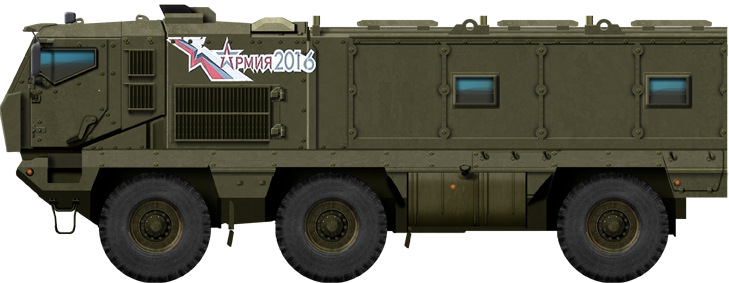
Typhoon K APC at Armiya 2016 Exhibition
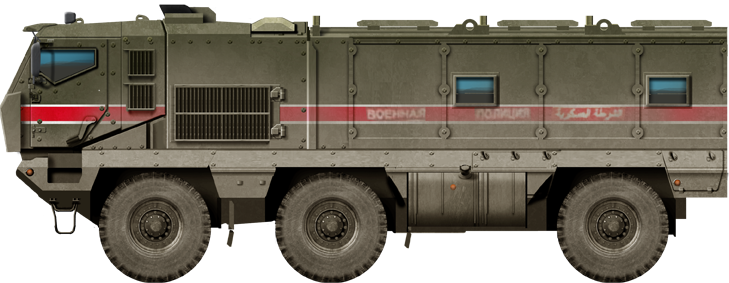
Typhoon K of the Military Police in Syria
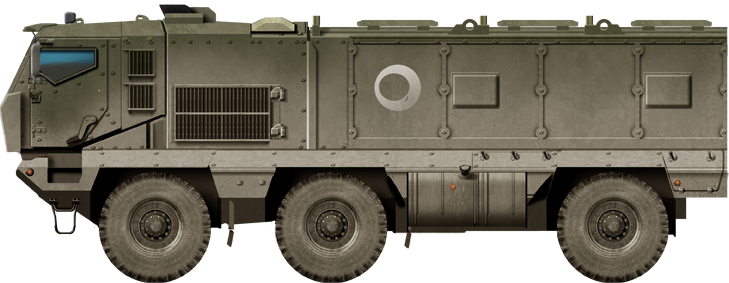
Typhoon K in Ukraine, damaged and abandoned, 2022, note the symbol unit ref
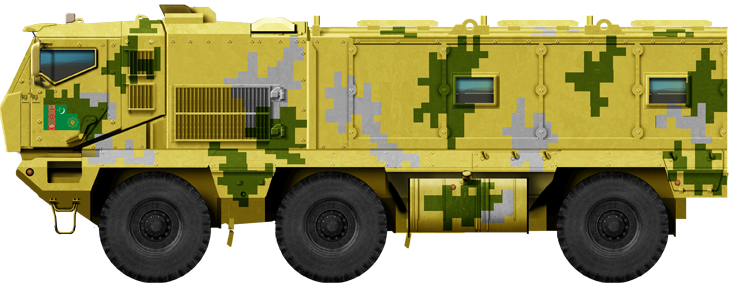
Turkmenistan Army Typhoon K
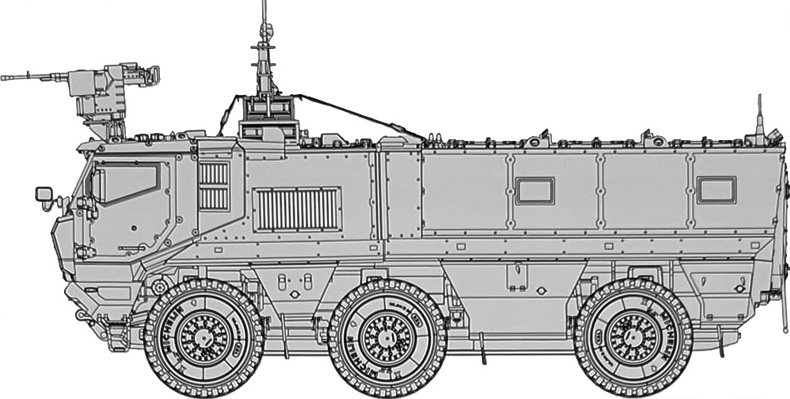
Typhoon K with a Radio-Diffusion Jammer and RWS
See also a civilian converted sport competition 4x4 variant
Gallery
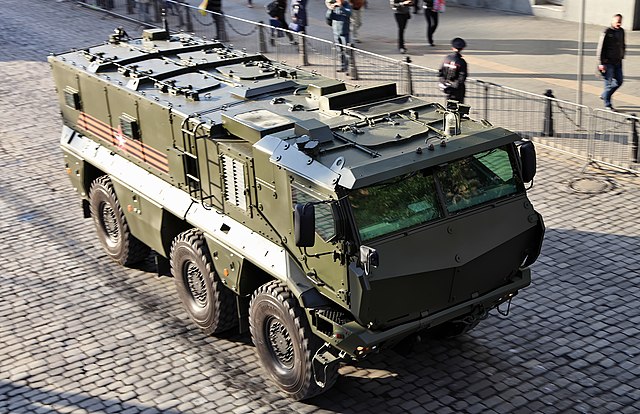
Victory Day Reharsal
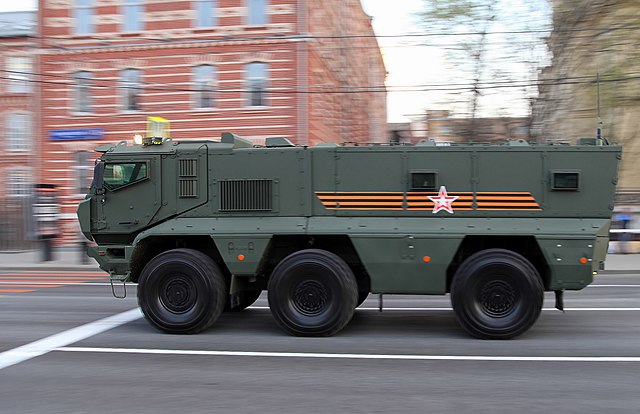
Reahrask 29 April Moskow 2015
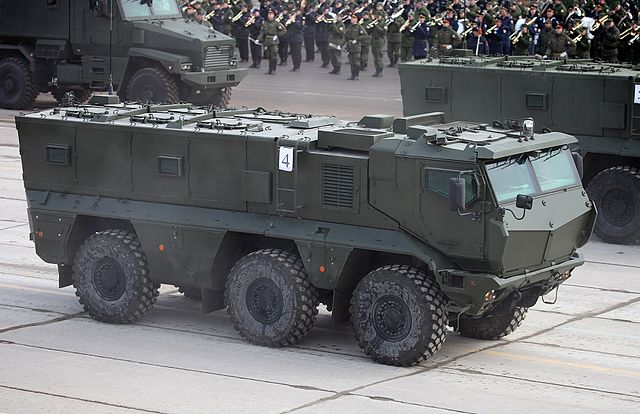
Vehicle at Alabino
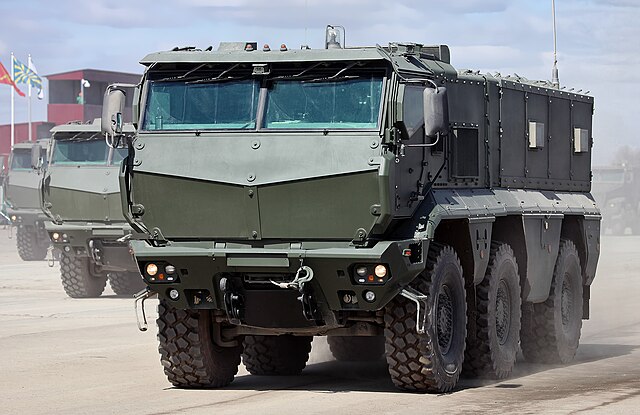
Kamaz 63968
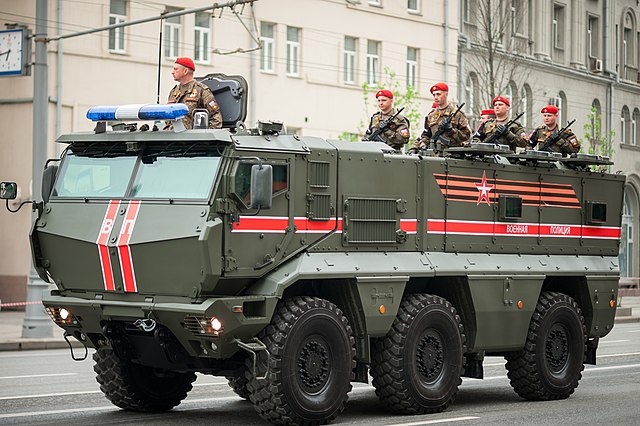
Vehicle of the Military Police
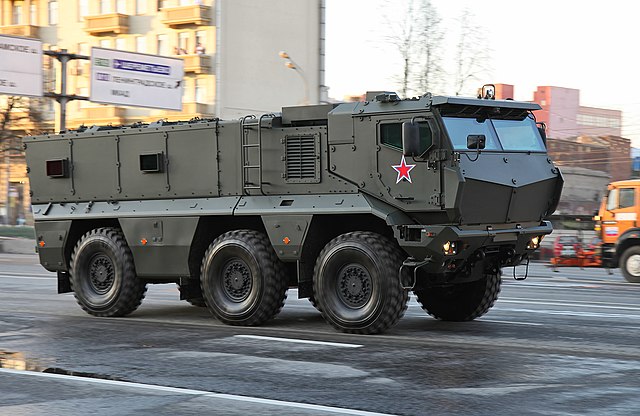
April 29th Reharsal of 2014 Victory Parade Moskow
Kamaz 63968
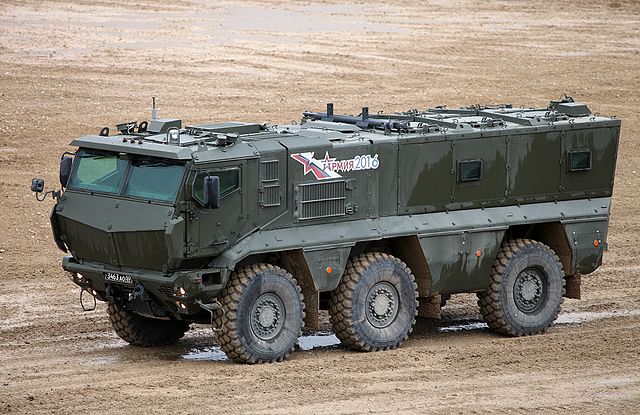
Armiya 2016
Video

Modern Tanks
Modern MBTs posters

Denel Bagder (2018)

Type 16 MCV (2016)

Gepard 1A2 last rounds 2011

SANDF

Russian AFVs

Main Battle Tanks
